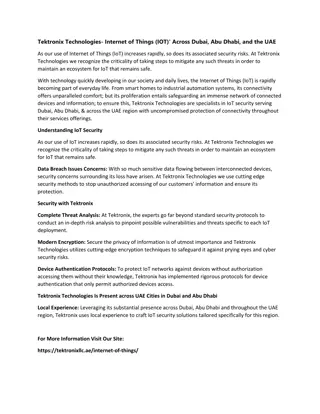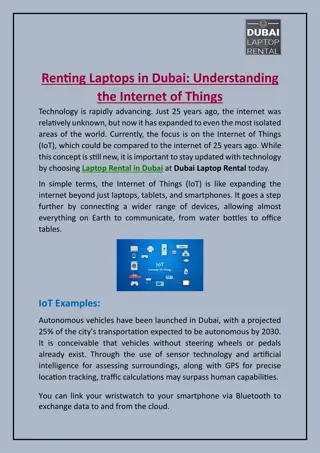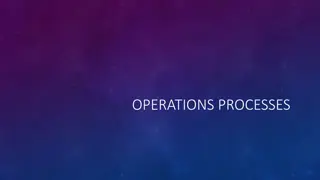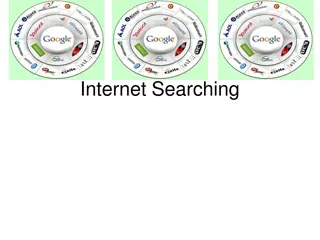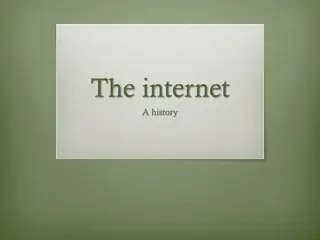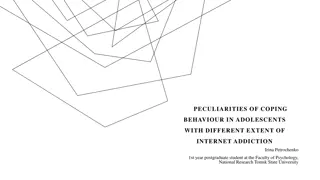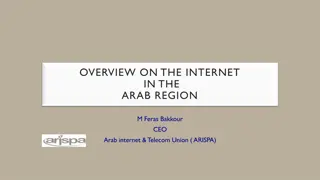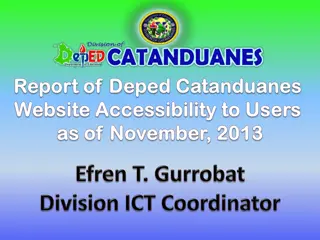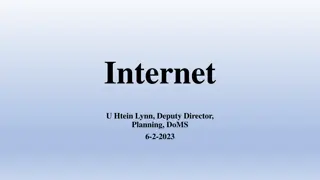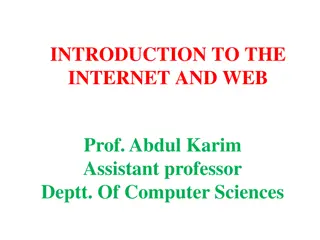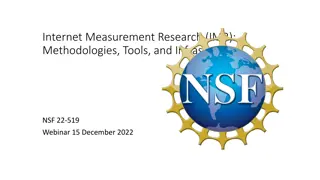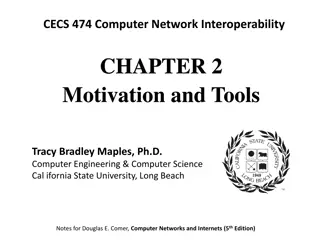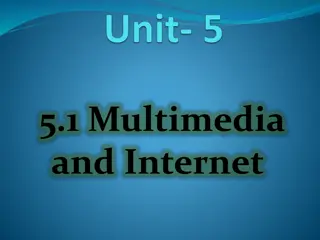The Internet of Things: Transforming Our World Through Technology
The Internet of Things (IoT) is revolutionizing how we interact with technology. Utilizing tools like Node-RED, MQTT, Mosquitto, Tasmota, and Raspberry Pi, wireless information transfer among smart devices in the home is becoming the norm. This brief overview explores the immense potential of IoT today, showcasing how existing hardware and affordable solutions can enhance our daily lives. Embrace this exponential advance in technology and delve into the possibilities of IoT for an interconnected future.
Download Presentation

Please find below an Image/Link to download the presentation.
The content on the website is provided AS IS for your information and personal use only. It may not be sold, licensed, or shared on other websites without obtaining consent from the author.If you encounter any issues during the download, it is possible that the publisher has removed the file from their server.
You are allowed to download the files provided on this website for personal or commercial use, subject to the condition that they are used lawfully. All files are the property of their respective owners.
The content on the website is provided AS IS for your information and personal use only. It may not be sold, licensed, or shared on other websites without obtaining consent from the author.
E N D
Presentation Transcript
Node-red, MQTT, Mosquitto, Tasmota Pi stuff and more! The internet of things (IOT) is an exponential advance in the way we use existing technology and a stepping stone to what is being developed for the future Transferring information wirelessly from and to intelligent devices in the home is becoming commonplace This is a brief overview of what can be done today with existing H/W and minimal cost.
Shelly Shelly is more hacker-friendly as it has program headers already installed designed to be used inside a power box.
The ESP8266 is a low-cost Wi-Fi microchip with microcontroller capability by Espressif Systems in China. ESP8285 is an ESP8266 with 1 MB of built-in flash The ESP32 is dual core 160MHz to 240MHz CPU whereas the ESP8266/8285 is a single core running at 80MHz. The ESP32 also has bluetooth and more interface capabilities. CAN bus, hall effect, touch sensors etc.
In general, programs written for one chipset can be run on another. All of these can run micropython if that is your program of choice.
TASMOTA: Acronym for Theo Arends Sonoff MQTT Over The Air. A Robust replacement for pre-programmed control devices. Supports local, web-based control, and HTTP control, it has built in timers, logging functions, configurable GPIO pins and MQTT capabilities.
Flashing is done with a FTDI adapter connected to programming pins. 4 pins are used, plus, minus, Tx and Rx. If you have a Raspberry Pi, it can be used as a programmer (save $1.25) The chip is read and the MAC address saved, then the original SW is backed up to a file, then it is erased and programmed. Takes about 5 minutes to do everything.
Browse to 192.168.4.1 and get the main screen for the Sonoff device
Go to Configuration and select the Wifi tab. Enter the ssid and password and reboot, then use your main Wifi connection to get a DHCP IP. Reboot and test through web address, then make IP static.
MQTT is a bi-directional signalling protocol developed in 1999 by Andy Stanford-Clark from IBM The acronym stands for Message Queuing Telemetry Transfer It uses a hub, called a broker to manage traffic initiated or sent to network nodes called clients. A message is said to be published when it is sent out to one or many clients. A client can subscribe to a published topic or not, as the case may be. There can be limitless topics, clients, and publishers. (Within reason) The published topic contains a message called a payload and its contents are acted on or ignored accordingly by the client, or the broker.
Enter the IP of the broker PC, then select a name to be used for the topic. The port address can remain as default. Enter a password if desired.
Implementation of MQTT Mosquitto is popular and available on many platforms, it is not installed by default on Raspbian. Node-red has a MQTT contributed-node available. Python has an MQTT component which we will visit next.
Python program utilizing mqtt module import paho.mqtt.client as mqtt #import the client import time from datetime import datetime from w1thermsensor import W1ThermSensor sensor = W1ThermSensor() x = chr(176) # this is the degree symbol broker_address="10.0.0.152" client = mqtt.Client("temperature") #create new instance client.connect(broker_address) #connect to broker # while True: celc = sensor.get_temperature() celsius=round(celc,2) tempf=celsius*9/5+32 tempf=round(tempf,2) print("The temperature is",celsius,x,"C") print("The temperature is",tempf,x,"F") now=datetime.now() print (now) client.publish("temperature",(tempf)) exit()
@reboot sleep 120 && nohup ~/fish.sh & #!/bin/bash while: do python3 fishtank.py sleep 5m done
I INSTALLING MOSQUITTO sudo apt-key add mosquitto-repo.gpg.key. ... cd /etc/apt/sources.list.d/ ... sudo wget http://repo.mosquitto.org/debian/mosquitto-wheezy.list. ... sudo wget http://repo.mosquitto.org/debian/mosquitto-wheezy.list. ... sudo -i. ... apt-get update. ... apt-get install mosquitto. Stat mosquitto with mosquitto -v Stop with sudo service mosquitto stop
Node-Red Written by Paul Morrison in the 1970s as a way of describing the behavior of black boxes connected to a network. It is written in Javascript and was developed by IBM. It is included as an application menu choice on RPi distributions from Rpi.org. It allows you to connect nodes, debug them and modify their behavior programmatically It has become open source and has over 2700 standard and user-contributed nodes. There is a dashboard feature that allows interaction with the program with a web interface that can be used on a computer, android, or smart phone.


